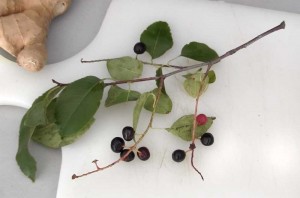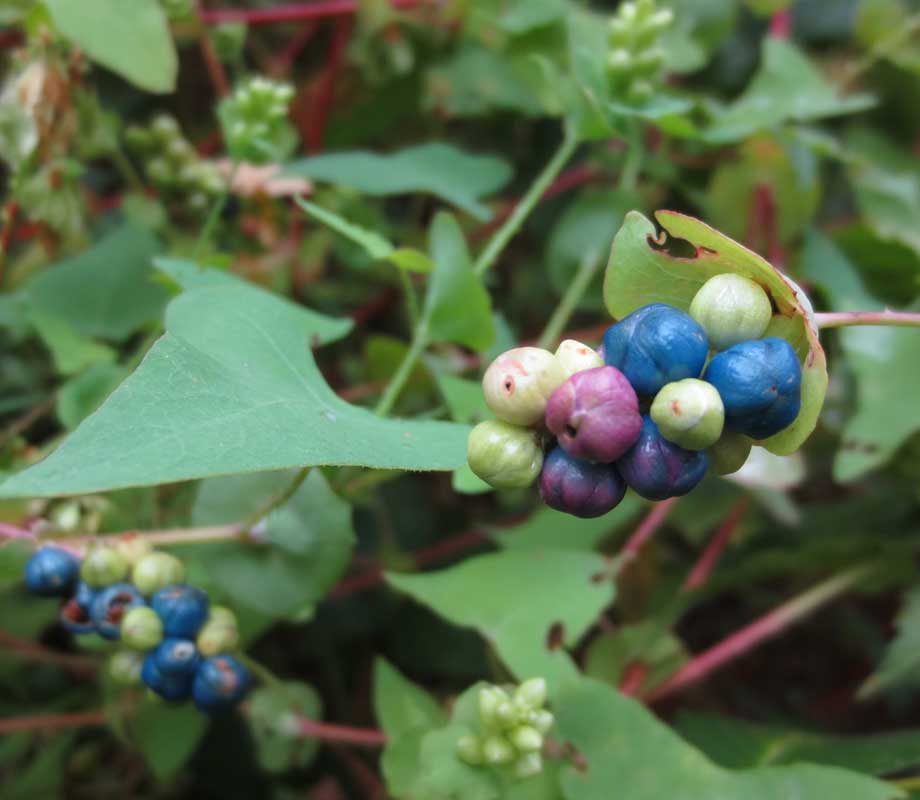August: This Season’s Wild Edible Plant: Black Cherries

Black cherry (Prunus serotina)
Every August, you can find black cherry trees covered in drooping clusters of shiny ripe fruit, like thousands of threaded beads. These cherries are smaller and more tart than the domestic varieties. They grow in elongated racemes and appear to be more like berries on little stalks. However, you will find that each “berry” contains an unmistakable cherry pit.
They are not as sweet as regular cherries, but their tannic tartness makes them ideal for making jam, jelly, syrups and wine. However, despite their being considered unpalatable, I really enjoy their sweet/sharp flavor straight from the tree, and will happily spend time munching away on them as a refreshing snack, whilst out walking.
The bark of the young tree is used for its medicinal properties, mainly as a cough remedy and sedative. However, avoid eating the leaves, as they contain cyanide, which reaches toxic levels once they are crushed or begin to wilt. Many cattle and horses have died from ingesting them. The pits are also poisonous, although they have to be crushed in order to release their cyanide content, so fear not, if you accidentally swallow one or two. They’ll just pass on through.
Unless you have a cherry pitter, removing all those pits can prove to be very time consuming. You can try rolling the fruit between two cutting boards to loosen up the pits, but this can be very messy. All in all, you won’t get a lot of fruit at the end of the day, so I’d recommend having some apples on hand. I’d recommend crab apples, but they are just as labor intensive as the cherries.
If you can pit sufficient cherries to make a cherry and apple pie, you won’t regret it. However, these wild cherries are not as sweet as regular cherries, and may require more sugar in the recipe (according to your taste preference). Pitted wild cherries make great accent fruits in fruit salads, green salads, and chicken and tuna salads. I’ve used them to make a sweet and tart sauce for fish, which I’m sure would work just as well with chicken & pork. For a wicked dessert idea, try soaking them in rum or brandy for a while, then pour them over ice cream or even waffles with some whipped cream.
We recently made some venison kaftas for a wild foods feast. Fortunately, black cherries were in season, so we made a black cherry sauce to accompany them. It was a big hit.
If you are lucky enough to be able to harvest some black cherries, try making a sauce. The recipe is fairly simple and easy to make. Depending on how much you reduce the sauce, you can make a useful black cherry syrup, which can be added to seltzer for a refreshing drink or taken straight as an very effective treatment for coughs and bronchitis.
See Lisa Caccamise’s recipe here
Share and Enjoy
1 Comment
You must be logged in to post a comment Login




Pingback: wild foraged organic non-GMO black cherry sauce recipe | Suburban Foragers